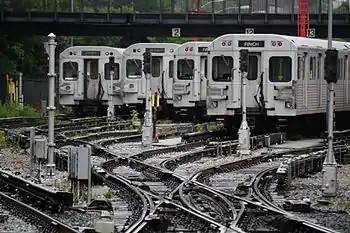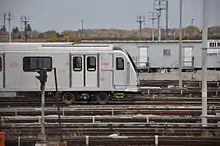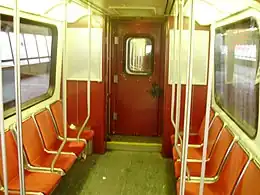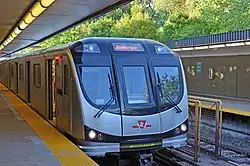
The Toronto subway system's rolling stock consists of 880 subway cars for Line 1 Yonge–University, Line 2 Bloor–Danforth, and Line 4 Sheppard. The rolling stock is owned and maintained by the Toronto Transit Commission (TTC).
Subway trains
| Identifier | Quantity | Year(s) built | Builder & model | Class | Date retired | Notes |
|---|---|---|---|---|---|---|
| 5000–5099 | 100 | 1953–1954 | GRC&W | G1 | October 6, 1990 | 5080–5081 experimentally retrofitted with fluorescent lighting. 5068–5069 converted to service cars RT-36 & RT-37 (grinding train power units) in February 1991; 5066–5067 & 5074–5075 had been held for future conversion to service cars; 5098–5099 preserved by the Ontario Electric Railway Historical Association. |
| 5100–5105 | 6 | 1954–1955 | GRC&W | G2 | October 6, 1990 | experimental aluminum train |
| 5200–5227 | 28 | 1956 | GRC&W | G-3 | October 6, 1990 | non-driving motor cars permanently coupled with mating G-1 cars (50xx-52yy-52xx-50yy) |
| 5110–5115 | 6 | 1958–1959 | GRC&W | G-4 | October 6, 1990 | experimental cars built as an integral train (5110-5111-5112-5113-5114-5115); electro-dynamic braking equipment and motors removed April 1966 through March 1967 (for installation in service cars), and remarshalled as: 5110–5115, 5030-5111-5114-5031. |
| 5300–5335 | 36 | 1962–1963 | MLW | M-1 | May 1, 1999 | 5300–5301 preserved by the OERHA |
| 5336–5499 | 164 | 1965–1966 | HSC RTC-75 | H-1 | November 29, 1999 | 5374–5375 rebuilt to service cars RT-9 & RT-10; 5388–5391 scrapped due to Christie station fire in October 1976; 5391 rebuilt to service car RT-23 in March 1984. |
| 5500–5575 | 76 | 1971 | HSC RTC-75 | H-2 | September 28, 2001 | 5500–5505 equipped with experimental Hitachi chopper controls and regenerative braking and reclassed as H-3 in 1973; converted back to H-2 between September 1984 and April 1985. |
| 5576–5663 | 88 | 1974–1975 | HSC RTC-75 | H-4 | January 27, 2012 | Last subway cars outfitted with vinyl orange upholstered seats, also the last of which not outfitted with air-conditioning systems. They also had similar interior design based from the H-2 subway cars, with reduced seating in a 2+2 configuration instead of 2+3 to allow for more standees. Some H-4 subway cars were retired from revenue service between 2000–2002 by the delivery of T-1 class cars. By January 27, 2012, all H-4 cars were retired from revenue service.[1] |
| 5670–5807 | 138 | 1976–1979 | HSC RTC-75 | H-5 | June 14, 2013 | 5755 retired in June 1984 and scrapped November 1985 due to accident in December 1981; 5754 modified in November 1985 for use as A or B unit to substitute for cars out of service for maintenance (can also operate as a single unit for testing); 5796 modified by UTDC in July–December 1990 to become T-1 prototype, which was retired and scrapped in September 2012; first subway cars outfitted with air-conditioning systems, all H-5 trains were retired from service by June 14, 2013, some of which were taken to Buffalo, New York for refurbishment, before being sold to the Lagos Rail Mass Transit, but scrapped by August 2015. |
| 5810–5935 | 126 | 1986–1989 | UTDC RTC-75 | H-6 | June 20, 2014 | Accessible seating areas were added near the operator's cab and the first set of doors in each car during technological upgrades (like the T-1s) between 2005 and 2008. All H-6 trains were retired from service by June 20, 2014. |
| 5000–5371 | 372 | 1995–2001[2] | BT RTC-75 | T-1 | Active | First cars with AC propulsion, cars 5344–5345 converted to Toronto Rocket T35A08 mock-up cars in June–July 2006. Electronic side destination signs, including automated audible pre-boarding route and destination announcements and closed-circuit television cameras have since been installed on all T1 trains. |
| 5381–6196[2] | 480[3] | 2009–2015[2] | BT T35A08 | Toronto Rocket | Active | 76 six-car permanently coupled trains with open gangways being delivered. First train delivered on October 1, 2010. Sets are numbered 5xx1-5xx2-5xx3-5xx4-5xx5-5xx6. In February 2013, set 5461–5466 was retrofitted with additional plastic yellow handholds, and external door chimes, displacing the exterior blue lights on the car. Similarly, another set, 5851–5856 was also modified with the same features as with set 5461–5466 in May 2014. External door chimes, electronic side destination signs, including automated audible pre-boarding route and destination announcements, have since been installed on all TR trains. First subway cars to adopt numbering in the 6000s. Set 5471–5476 was temporarily converted to a four-car train for testing purposes on Line 4 Sheppard, which were converted to full Toronto Rocket operation. After the testing phase, six additional four-car trains were received for use on Line 4, which reduced the original 80 six-car trainset order to 76 six-car trainsets. Unlike the six-car trains, the four-car trains feature two pairs of A (cab) and B (non-cab) cars, numbered 6xx1-6xx2-6xx5-6xx6. All six four-car TR Trains are in service on Line 4 and all seventy-six six-car TR Trains are in service on Line 1. |
| Builders | |
|---|---|
| BT | Bombardier Transportation |
| GRC&W | Gloucester Railway Carriage & Wagon Co. |
| HSC | Hawker-Siddeley Canada |
| MLW | Montreal Locomotive Works |
| UTDC | Urban Transportation Development Corp. |
![]() All TTC subway cars are equipped with flip-up seats located in each car (near the operator's cab), which can accommodate mobility devices such as wheelchairs, strollers, scooters, and bicycles, the new Toronto Rocket trains have two designated areas in each car with automatic flip-up seats, although level boarding platforms allow a degree of access to all trains.
All TTC subway cars are equipped with flip-up seats located in each car (near the operator's cab), which can accommodate mobility devices such as wheelchairs, strollers, scooters, and bicycles, the new Toronto Rocket trains have two designated areas in each car with automatic flip-up seats, although level boarding platforms allow a degree of access to all trains.
Toronto Rocket

The Toronto Rocket (TR) is the newest version of TTC subway trains, which is operated on Lines 1 and 4.[4] Its design deviates from its predecessors, which were formed by building trains from married pairs of identical cars. The trains consist of six cars for Line 1 and four cars for Line 4, both of which are connected with open gangways, similar to Bombardier's Movia family of metro trains. They only have two full-width operator cabs per trainset (as opposed to one on the right-hand corner of every subway car on the older versions), greater accessibility options and the skin of the train is welded rather than the previously used riveting method. The TRs' exterior front and rear destination and train run number signs are outfitted with digital orange LED boards, while all previous TTC train models use back-lit roller signs.
The first of the new TR trains was scheduled to be delivered in late 2009, but in early 2010, TTC officials stated that the new trains would not enter service until late 2010.[5][6] The first train arrived on TTC property in October 2010, and entered revenue service on July 21, 2011.[7]
Next-generation cars
In October 2022, the TTC issued a request for proposal for new subway trains, which are targeted to enter service between 2027 and 2033.[8]
| Quantity | Year(s) built | Pre-qualified potential builders | Class | Notes |
|---|---|---|---|---|
| ~480[9] | 2027–2033 (estimated)[9] | Alstom Transport Canada (Canada), CRRC Qingdao Sifang (China), Hyundai Rotem (South Korea), Kawasaki Rail Car (Japan)[8] | TBD | Order will replace the current T-1 rolling stock[9] |
Line 3 Scarborough trains
All units retired on July 24, 2023 (at the time of closure, 4 months ahead of schedule due to a derailment).[10]
| Identifier | Quantity | Year(s) built | Builder & model | Notes |
|---|---|---|---|---|
| 3000–3027 | 28 | 1982–1983, 1986 | UTDC ICTS Mark I | 3014 was displayed at the 1983 Canadian National Exhibition. All units have been refurbished. Refurbished cars include, since 2015, electronic side destination signs, including automated exterior audible pre-boarding route and destination announcements, along with closed-circuit television cameras and a new vinyl wrap. |
| ST-1 | 1 | Niigata Transys | Centre-cab diesel locomotive | |
| ST-2 | 1 | likely Arva Industries | Non-motored crane and rail maintenance car | |
| ST-3 | 1 | Niigata Transys | Non-powered rail grinding truck | |
| ST-4 | 1 | Schmidt | Snow-blower installed on a non-powered PCC truck | |
| ST-5 | 1 | Non-powered power rail cleaner and de-icer | ||
| ST-7 | 1 | 2002 | Arva Industries snowblower attached to Mercedes-Benz Unimog U 5000 short cab (with crane) | |
| E291 | 1 | New Holland TC 18 tractor | Tractor used to push Line 3 cars where there is no power to operate cars |
 A Line 3 train in its typical four-car configuration in its original 1985–2015 livery
A Line 3 train in its typical four-car configuration in its original 1985–2015 livery An interior view of a Line 3 train
An interior view of a Line 3 train
Work vehicles
Most subway work cars are painted yellow with the fleet number as RTXX. The exception are converted subway cars, which are not repainted (strips added) and have the RT fleet number replacing their former fleet number.
Current subway work vehicles
| Identifier | Description | Year acquired | Year retired |
|---|---|---|---|
| RT-1 | Rail maintenance car | 1909 by Toronto Railway Company and rebuilt five times | |
| RT-2 | Flat car | 1997 by Arva Industries | |
| RT-3 | Overhead maintenance car | 1922 by Toronto Transportation Commission | |
| RT-5 | Tunnel leak repair (grout) car | 1997 by Arva Industries | |
| RT-6 | Vacuum cleaning car | 1922 by Toronto Transportation Commission | |
| RT-7 | Diesel locomotive | 1998 by Plasser American | |
| RT-8 | 13 rail delivery articulated bogies | 1997 by Plasser American | |
| RT-10 | Works Services Car (ex-garbage car unit), ex-H1 RTC-75 subway car 5374 | 1965–66 Hawker Siddeley Canada and converted 2000 by TTC | Replaced old RT-10, 1968 Tokyo Rose (Nippon Sharyo) |
| RT-11 | Non motored car | 2000 by Arva Industries | |
| RT-12 (2nd) | Electric locomotive | 2009 by Arva Industries | |
| RT-13 | Centre cab crane car | 1968 by Nippon Sharyo | |
| RT-14 (2nd) | Mk III snow clearing unit | Arva Industries | |
| RT-15 (2nd) | Mk III snow clearing unit | Arva Industries | |
| RT-16 | Tunnel washer – "The Clean Machine" | 1996 Arva Industries – used with RT-17 | |
| RT-17 | Tunnel washer – "Krystal Klean" | 1996 Arva Industries – used with RT-16 | |
| RT-18 | Diesel locomotive | 1977 by Anabel Corporation of Houston, Texas | |
| RT-19 | Flat car | 1980 Niigata Transys Company | |
| RT-20 | Crane car | 1980 Niigata Transys Company (crane by Arva Industries) | |
| RT-21 | Flat car | 1980 by Niigata Transys Company | |
| RT-22 | Flat car | 1973 by Nippon Sharyo | Formerly RT-17 wash car and rebuilt 1996 as flat car |
| RT-23 | Non motored asbestos abatement car, ex-H1 RTC-75 subway car 5391 | 1965–66 Hawker Siddeley Canada and converted by TTC 1984 | |
| RT-26 | Gauge car | 1980 by TTC | |
| RT-27 | Beam transporter and crane | 1950s Gloucester Railway Carriage and Wagon Company bogies and reused 1986 by TTC | |
| RT-28 | Flat car with crane | 2000 by Arva Industries | |
| RT-29 | Flat car | 2001 by Arva Industries | |
| RT-38 | Ex-garbage car unit, ex-H1 RTC-75 subway car 5422 | 1965–66 Hawker Siddeley Canada and converted 1997 by TTC | |
| RT-39 (3rd) | Flat car | 2011 by Arva Industries | |
| RT-40 | Ballast car | 1989 by Dynex | |
| RT-41 | Tie tamper car | 1993 by Plasser American | |
| RT-42 | Scaffold car | 1999 Arva Industries | |
| RT-43 | Asbestos abatement crew car, ex-H1 RTC-75 subway car 5459 | 1965–66 Hawker Siddeley Canada and converted 2000 by TTC | |
| RT-44 | Asbestos abatement crew car, ex-H1 RTC-75 subway car 5458 | 1965–66 Hawker Siddeley Canada and converted 2000 by TTC | |
| RT-45 | Asbestos abatement garbage car, ex-H1 RTC-75 subway car 5337 | 1965–66 Hawker Siddeley Canada and converted 2000 by TTC | |
| RT-46 | Asbestos abatement garbage car, ex-H1 RTC-75 subway car 5336 | 1965–66 Hawker Siddeley Canada and converted 2000 by TTC | |
| RT-47 | Flat car | 1999 by Arva Industries | |
| RT-48 | Motored snow blower | 2001 by Arva Industries | |
| RT-49 | Motored snow blower | 2001 by Arva Industries | |
| RT-50 | Non motored push snow thrower | 1999 by Arva Industries | |
| RT-51 | Non motored push snow thrower | 1999 by Arva Industries | |
| RT-52 | Non motored push snow thrower | 1999 by Arva Industries | |
| RT-53 | Non motored push snow thrower | 1999 by Arva Industries | |
| RT-54 | Flat car | 1973 by Nippon Sharyo | Replaced ex RT-16 or ex RT-17 |
| RT-55 | Flat car with crane | 2000 by Arva Industries | |
| RT-56 | Vacuum rodder car | 2004–2005 by Arva Industries | |
| RT-57 (2nd) | General Purpose Rail Flat Car | 1999–2000 Arva Industries | |
| RT-58 | Works Service Car, ex H4 RTC-75 subway car 5635 | 1974–75 Hawker Siddeley Canada and converted by TTC | |
| RT-60 | Works Service Car, ex-H4 RTC-75 subway car 5594 | 1974–75 Hawker Siddeley Canada and converted by TTC | |
| RT-61 | Works Service Car, ex-H4 RTC-75 subway car 5595 | 1974–75 Hawker Siddeley Canada and converted by TTC | |
| RT-62 | Works Service Car, ex-H4 RTC-75 subway car 5616 | 1974–75 Hawker Siddeley Canada and converted by TTC | |
| RT-63 | Works Service Car, ex-H4 RTC-75 subway car 5617 | 1974–75 Hawker Siddeley Canada and converted by TTC | |
| RT-64 | Works Service Car, ex-H4 RTC-75 subway car 5594 | 1974–75 Hawker Siddeley Canada and converted by TTC | |
| RT-65 | Works Service Car, ex-H4 RTC-75 subway car 5595 | 1974–75 Hawker Siddeley Canada and converted by TTC | |
| RT-66 | Works Service Car, ex-H1 RTC-75 subway car 5386 | 1964–65 Hawker Siddeley Canada and converted by TTC | |
| RT-67 | Works service car, ex-H1 RTC-75 subway car 5387 | 1964–65 Hawker Siddeley Canada and converted by TTC | |
| RT-68 | Fibre Optics testing car, ex-H1 RTC-75 subway car 5408 | 1964–65 Hawker Siddeley Canada and converted by TTC | |
| RT-69 | Fibre Optics testing car, ex-H1 RTC-75 subway car 5409 | 1964–65 Hawker Siddeley Canada and converted by TTC | |
| RT-70 | Flat car | 2005 by Arva Industries | |
| RT-71[11] | Tri-Mode Work Locomotive, self-propelled | 2006 Arva Industries | |
| LPC-5 | Rail grinding train 3 car set | 2000s LORAM Maintenance of Way, Inc.-owned L-series grinder on lease/contract |
Retired
| Identifier | Description | Year acquired | Year retired |
|---|---|---|---|
| Unnumbered (1st) and RT-11 (2nd) | Duncan’s Dragon — test car for 75-foot subway cars (all subway cars since the M1) based on G-car specifications[12] Consists of three sections based on the profile of G-cars connected by long metal box and two bogies. | 1964 built by TTC Duncan Shops | Retired 1965? 1st car was built with wood, 2nd car used in 1977 along Spadina line has metallic frame and was located at Greenwood Yard c. 2007 |
| RT-4 (1st) | Garbage Car Unit – ex-Peter Witt 2528 | 1920s Canadian Car and Foundry and refurbished 1954 by TTC | Retired 1970s |
| RT-4 (2nd) | Track re-insulation car | 1997 by Arva Industries | Retired 2013 |
| RT-9 | Works Services Car, ex-H1 RTC-75 subway car 5350 | 1965–66 Hawker Siddeley Canada and converted by TTC | Destroyed by fire on December 8, 2000 |
| RT-10 – Tokyo Rose | Garbage car unit | 1968 by Nippon Sharyo | Retired 2000 and replaced by current RT10; scrapped |
| RT-12 (1st) | Electric locomotive | 1968 by Nippon Sharyo | Retired 2009 |
| RT-34 | grinding car ex-G2 5102 | 1954–55 Gloucester Railway Carriage and Wagon Company and converted 1988 by TTC | 2003 damaged in accident and stored at Davisville Yard |
| RT-35 | Grinding train, ex-G2 5103 | 1954–55 Gloucester Railway Carriage and Wagon Company and converted 1988 by TTC | Retired and scrapped 2007 |
| RT-14 and R-15 | Rail grinder – former PCC A-7 4446 and 4410 MU cars | 1949 Canadian Car and Foundry and converted 1970s by TTC | Replaced 1991 by then RT-36 and RT-37 (next row below) |
| RT-30 | Non motored grinding truck | 1988 by Ecolaire | Retired 2008 |
| RT-31 | Non motored grinding truck | 1988 by Ecolaire | Retired 2004 |
| RT-32 | Non motored grinding truck | 1988 by Ecolaire | Retired 2004 |
| RT-33 | Non motored grinding truck | 1988 by Ecolaire | Retired 2008 |
| RT-36 | Grinding train, ex-G1 5068 | 1953–54 Gloucester Railway Carriage and Wagon Company and converted 1991 by TTC | Retired and scrapped 2007 |
| RT-37 | Grinding train, ex-G1 5069 | 1953–54 Gloucester Railway Carriage and Wagon Company and converted 1991 by TTC | Retired and scrapped 2007 |
| RT-38, ex-G2 5100 | Garbage cars | 1954–55 Gloucester Railway Carriage and Wagon Company and converted by TTC G-2 5100 and 5105 | Retired and scrapped 1998 |
| RT-39 (1st), ex-G2 5105 | Garbage cars | 1954–55 Gloucester Railway Carriage and Wagon Company and converted by TTC G-2 5100 and 5105 | Retired and scrapped 1998 |
| RT-39 (2nd) | ex-Garbage car unit, ex-H1 RTC-75 subway car 5423 | 1965–66 Hawker Siddeley Canada and converted 1997 by TTC | Retired 1997 |
| RT-14 (ex RT-36) | Tunnel washing cars | 1954–55 Gloucester Railway Carriage and Wagon Company G-2 and converted 1988 by TTC | Retired 1999 |
| RT-15 (ex RT-37) | Tunnel washing cars | 1954–55 Gloucester Railway Carriage and Wagon Company G-2 and converted 1988 by TTC | Retired 1999 |
| RT-57 (1st) | Works Service Car ex-H4 5634 | 1974–75 Hawker Siddeley Canada converted by TTC | Retired and replaced by new RT-57 |
- Note that RT35 and RT36 are mixed-matched (2004).
Track gauge
The TTC uses two different track gauges:
- 1,435 mm (4 ft 8+1⁄2 in) – Line 3 Scarborough, which uses standard gauge
- 4 ft 10+7⁄8 in (1,495 mm) – Subway
References
- ↑ Long-running subway car takes final journey Toronto Star, published January 27, 2012.
- 1 2 3 Toronto Transit Commission (March 6, 2015). "TTC Service Summary – March 29,2015 to May 9, 2015" (PDF). Retrieved 2015-03-22.
- ↑ "Procurement Authorization Amendment to Purchase 10 Additional Toronto Rocket Train Sets – Purchase Order No. C31PD05761" (PDF). Toronto Transit Commission. 2015-03-26. Retrieved 2015-03-22.
- ↑ globeandmail.com: Technology Archived 2006-02-02 at the Wayback Machine
- ↑ (as of December 2008) http://www3.ttc.ca/PDF/About_the_TTC/yonge_subway_extension_recommended_concept_project_issues_de.pdf
- ↑ (media article on other topic suggests trains will not enter service until 2010, as of Dec. 18th there are no TR trains in TTC's possession) "TTC offers free rides on New Year's Eve – 680News". Archived from the original on 2009-12-19. Retrieved 2009-12-18.
- ↑ So what happened to those TTC improvements? Toronto Star
- 1 2 "TTC Issues RFP for New Subway Trains". 20 October 2022.
- 1 2 3 Gamrot, Sabrina (October 21, 2022). "The TTC is looking to add hundreds of brand new red subway cars". blogTO. Retrieved January 8, 2023.
- ↑ "TTC, City improving Line 3 Scarborough bus shuttle routes as train service set to permanently end". August 24, 2023.
- ↑ "Archived copy" (PDF). Archived from the original (PDF) on 2011-07-07. Retrieved 2010-11-16.
{{cite web}}: CS1 maint: archived copy as title (link) - ↑ Coupler – March history – Remembering the fabled Duncan’s Dragon


_(14918534190).jpg.webp)